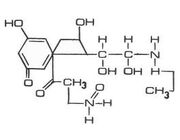
Chemical Makeup of Cordrazine
Cordrazine was a strong chemical stimulant created on Earth in 1987. It is classified as a "autonomic nervous system stimulant" by Starfleet Medical.
It was originally used in cryogenic laboratories to stimulate production of epinephrine and norepinephrine in the Human brain, allowing nerve transmission to be restored to the frozen body. (Star Fleet Medical Reference Manual)
By the 24th century, a more potent form of cordrazine had been developed, tricordrazine. (TNG episode: "Ethics")
Effect on Body
It creates an increase in myocardial contraction due to an influx of calcium into the fibers, resulting in a more complete emptying of the ventricles and an increase in cardiac work plus oxygen consumption. It also stimulates the production of natural occuring epinephrine and norepinephrine at the myoneural junctions and autonomic synapses in the brain.
It is specifically used for:
- Reviving nerve impulse transmission in the brain
- Increasing myocardial contraction, Punkinje fiber effect, speeding up the heart in times of heart failure or heart flutter.
The standard dosage for Humans is 0.25 cc. Taking it also comes with a number of side effects, including: elevated blood pressure, dry mouth, tachycardia, restlessness, insomnia, irritability, increased anxiety, paranoia, and death if overdosed. (Star Fleet Medical Reference Manual)

Dr. McCoy after injecting himself with cordrazine
Despite these effects, it was used by Starfleet doctors in the 23rd century during emergency medical situations, primarily to stimulate the heart during cardiac arrest.
One example of excessive amounts of cordrazine being known to cause temporary dementia and violent paranoia was in 2267, when Dr. Leonard H. McCoy had been summoned to the bridge after a short circuit at the helm console injured Lt. Hikaru Sulu. McCoy decided to risk a few drops of cordrazine, despite Captain Kirk's concerns that it was "tricky stuff." After reviving Sulu with a couple drops of cordrazine, McCoy was standing at the helm console, checking his hypospray when the ship was hit by a shock wave. Trying to hold himself steady, McCoy accidentally pushed the hypospray into his mid-section, and injected himself with all the cordrazine remaining in the hypospray. After waking up in an agitated state, he immediately suspected that his crewmates were trying to kill him, and escaped to the planet Gateway. (TOS episode: "The City on the Edge of Forever", and novel: The Klingon Gambit)
Background
Although stated to have been invented in 1987, no such chemical has ever been made in real life. It was also referenced (as a real chemical) in the TV series Mission: Impossible.
